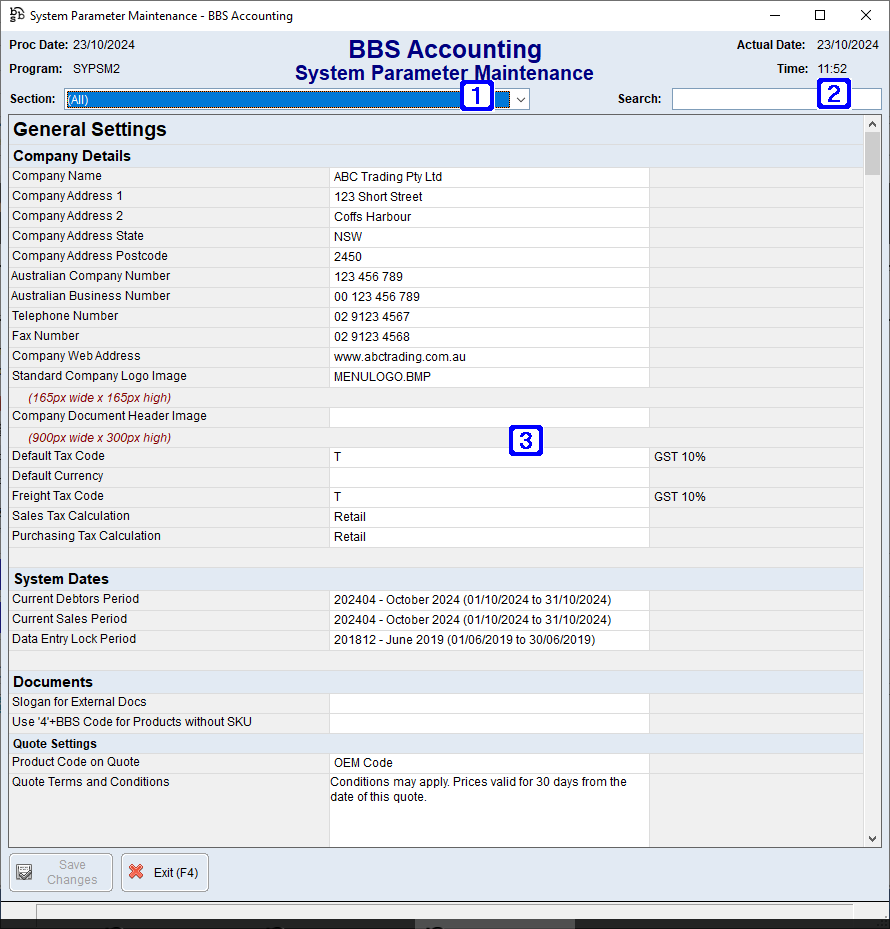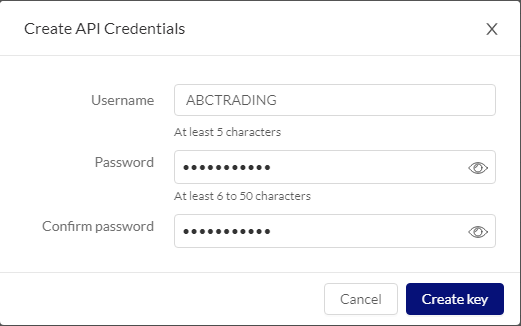Inventory Control:
•Number of days prior to despatch to allocate stock - Allocate stock to forward sales orders 'x' days prior to despatch.
o0 - allocate stock to all orders when created regardless of pick date.
o1-999 - do not allocate stock to orders where the pick date is greater than this number of trading days in advance.
•Default Catalogue - The default external party catalogue.
•Default UOM - The unit of measure that all products will default to when created in Product Masterfile Maintenance.
•Default Warehouse - The warehouse code that all products will default to when created in Product Masterfile Maintenance.
•Qty Decimal Places Allowed -
o0 - Only sell products in whole numbers.
o1-5 - Allow fractional quantities to be entered.
•Stock/COGS Cost Price Decimal Places Allowed - Average Cost/Cost of Sales Costs decimal places allowed, 5 - recommended for all systems to ensure accurate stock costing.
•Use Stock - G/L Interface - Use Live Perpetual Stock -> Financials (G/L) Interface -
oYes - BBS will journal to the G/L all stock in/out transactions.
oNo - Stock will be handled manually in the balance sheet.
•Use System Generated Product Codes by Default -
oYes - In most cases, BBS will assign product codes automatically based on the settings on each product group.
oNo - Product Codes are determined manually by users when new products are created.
•Email Address(es) for Product Code Requests - Email address(es) for New Product Code Request notifications.
•I/C Documents Locations String - The programming string indicating the location of the inventory attachments folder.
•I/C Templates Location String - The programming string indicating the location of the inventory templates folder.
•Number of days+ of no movement for a product to be considered Dead Stock - The number of days of no movement for a product to be considered Dead Stock, 9999 - Will disable !DEAD STOCK! notations.
•Number of days+ of no receipts for a product to be considered Slow Moving - The number of days of no receipts for a product to be considered slow moving.
•Number of days+ of available stock for a product to be considered Slow Moving - The number of days of available stock for a product to be considered slow moving, 9999 - Will disable !SLOW STOCK! notations.
•Default Shelf/Product Label- The default shelf/product label size. Where a shelf/product label size is not populated, BBS will default to standard size 89mmx25mm.
Lotted Items:
•FIFO/LIFO - Allocate from lots.
oF - FIFO - First In, First Out.
oL - LIFO - Last In, First Out.
•Lotted Item ID #1 to #5 - Description - Description of lotted item ID. Up to 5 lotted item field ID's can be determined. ie. Serial number, Batch number etc
•Lotted Item ID #1 to #5 - Required -
oYes - The lotted item ID data is required to be entered upon receipt of goods.
oNo - The lotted item ID data is not required.
•Lotted Item ID #1 to #5 - Public -
oYes - The lotted item ID data will appear on customer documents.
oNo - The lotted item ID data will not be appear on customer documents.
•Lotted Item ID #1 to #5 - Warn dupes -
oYes - Will warn when duplicate lotted item ID data is entered.
oNo - Will not warn when duplicate lotted item ID data is entered.
•Default Bundle Method - Single - When receipting/adjusting in stock, assume quantities will be receipted into individual lots/batches, Bundled - When receipting/adjusting in stock, assume quantities will be receipted into one or more lots/batches of varying quantities.
•ID containing Serial No for service module - Lotted item field ID number containing serial number for Service and Maintenance module (if required).
Inventory Control Accounts:
•Stock Asset Account - The general ledger account number for stock assets.
•Stock Asset Cost Centre - Cost Centres should only be filled in if you wish to override the cost centre on individual warehouses.
•Stock Adj Account - The general ledger account number for stock adjustments.
•Stock Adj Cost Centre - Cost Centres should only be filled in if you wish to override the cost centre on individual warehouses.
•Stocktake Adj Account - The general ledger account number for stocktake adjustments.
•Stocktake Adj Cost Centre - Cost Centres should only be filled in if you wish to override the cost centre on individual warehouses.
•Receipt Accruals Account - The general ledger account number for receipt accruals.
•Receipt Accruals Cost Centre - Cost Centres should only be filled in if you wish to override the cost centre on individual warehouses.
•P/O Markup Account - The general ledger account number for purchase order markups.
•P/O Markup Cost Centre - Cost Centres should only be filled in if you wish to override the cost centre on individual warehouses.
•Non-Inventory Cost Recovery Acc - The general ledger account number for non-inventory cost recovery.
•Non-Inventory Cost Recovery C/C - Cost Centres should only be filled in if you wish to override the cost centre on individual warehouses.
•Charge & Hold Liabilty Account - The general ledger account number for charge and hold liabilities.
•Charge & Hold Liability C/C - Cost Centres should only be filled in if you wish to override the cost centre on individual warehouses.
•Sales Returns Clearing/Variance Account - The general ledger account number for sales returns clearing/variances.
•Sales Returns Clearing/Var C/C - Cost Centres should only be filled in if you wish to override the cost centre on individual warehouses.
•Stock Loss/Gain Account - The general ledger account number for stock losses/gains.
•Stock/Loss Gain C/C - Cost Centres should only be filled in if you wish to override the cost centre on individual warehouses.
|







 to search. If left blank, manual entry will be required.
to search. If left blank, manual entry will be required.



